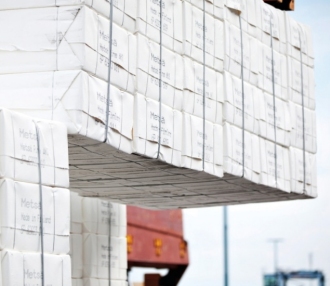
 As a result of COVID-19, the demand for napkins — paper towels which are used in the outdoor environment (Away-from-Home) by the consumers — plummeted. However, the consumption of kitchen towels (At-Home) increased, since more people were having their meals at home.
As a result of COVID-19, the demand for napkins — paper towels which are used in the outdoor environment (Away-from-Home) by the consumers — plummeted. However, the consumption of kitchen towels (At-Home) increased, since more people were having their meals at home.
Editor's note: The following article was published online by Metsä Fibre.
Jan. 30, 2021 - The unexpected outbreak of COVID-19, has had negative impacts on various industries, including the paper industry in China. When the economy slowed down, the tourism industry and the food and beverage sector took a hit. As a result, the demand for napkins — paper towels which are used in the outdoor environment by the consumers — also plummeted.
However, the consumption of kitchen towels increased, since more people were having their meals at home. Most factories resumed production, but in general the output in the first quarter of 2020 was affected by the COVID-19 pandemic.
"Investment in new production capacity decreased in the first half of 2020 due to the cumulative effects of overcapacity, heated competition and the COVID-19 outbreak. The top players in the industry managed to boost profits during pandemic thanks to advantages of scale, brand effects, developed sales pipelines and varied product portfolios," says Mr. Zhenlei Cao, President of the China Technical Association of Paper Industry (CTAPI).
The COVID-19 pandemic changed people's way of life, including the usage of tissue paper. During the outbreak, online sales increased. It is clear that the increased consumption of tissue is brought on by changes in awareness concerning hygiene.
"We can see that the demand for tissue picked up and that customers have higher expectations on the speed of logistics. Meanwhile, customers now have a stronger interest in higher-quality products. We will also see more environmentally friendly packaging in the market," says Mr. Martin Ng, Marketing Manager from Luck Tissue.
The chairman of Jinboshi Group, Mr. Junqing Zhang, has found multiple ways to respond to the COVID-19, including solutions that focus on long-term branding strategies, investment in e-commerce promotion and intensified sales in convenience stores.
"The average consumption of tissue paper in China amounted to 6.9 kg per person in 2019, which is still lower than in developed countries. Considering the economic development and the improving living standard, we are very positive about the prospects for the tissue paper market in China," says Mr. Guanbiao Deng, the CEO of C&S Paper.
"The average consumption of tissue paper in China amounted to 6.9 kg per person
in 2019, which is still lower than in developed countries."
– Mr. Guanbiao Deng, CEO of C&S Paper.
"We are dedicated to the R&D (research and development) and sales of high-end tissue paper products. In our business it is equally important to understand the market demand and to provide our customers with products that fit their needs and desires," says Mr. Deng.
C&S Paper and similar businesses can see how customer demand is shifting. Toilet paper's share is falling, however, while facial tissues see an increase. The reason for this trend is that facial tissues are getting more accepted by customers and are now serving purposes that toilet paper used to satisfy.
"The demand gap between the structure of the tissue paper market in China and the markets in developed countries is closing. Moreover, the growth rate of China's market is expected to be higher than the global average, making China the fastest growing region in the world," Mr. Cao from CTAPI explains.
 Metsä Fibre provides pulp for its tissue-producing customers in China.
Metsä Fibre provides pulp for its tissue-producing customers in China.
"Tissue paper producers are now competing to develop more differentiated products that have higher added values, through increasing focus on product functionalities."
The tissue paper market in China is very competitive. According to Mr. Cao, the market is key in the allocation of resources and most brands are privately owned.
Metsä Fibre provides raw material for its tissue-producing customers in China.
"Metsä Fibre has good raw-material resources and state-of-the-art factories. The quality of their pulp products meets the requirement for our production of tissue paper. Metsä Fibre has a flexible supply chain and can provide material by rail between Europe and China. This has shortened the door-to-door delivery time from 80 days to 20 days," says Mr. Deng from C&S Paper.
"In addition, the foresight of Metsä Fibre in terms of environmental management brings value to our own exploration and execution of sustainable strategies."
Metsä Fibre is a leading producer of bioproducts and bioenergy. Metsä Fibre produces pulp and other bioproducts at four mills in Finland: Joutseno, Kemi, Rauma and Äänekoski; and also has six sawmills: Kyrö, Lappeenranta, Merikarvia, Renko and Vilppula (in Finland) and in addition, Metsä Svir sawmill in Russia. To learn more, visit: www.metsafibre.com.
SOURCE: Metsä Fibre
Paper Industry Newsletter
Stay on top of paper industry news
from around the world with
PaperAge's free weekly newsletter.
Delivered every Thursday.
Sign up today!